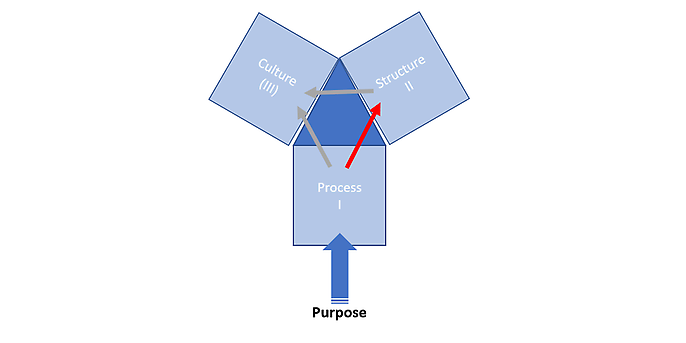14. June 2023 By Guido Schmitter
The 3⁴ concept for organisational development
It does not matter why a change comes about – it could be one competitor offering a new service or a different one offering a new technology – but ultimately, having to deal with this type of challenge has long since been part and parcel of business. That being said, however, defaulting to the knee-jerk approach of preserving old structures (after all, they have worked well for a long time now) and merely adding a functional extension only solves the problem in part. Converting a single team to work using agile methods also has a very limited impact. If we view organisation as more than just an administrative framework – namely a structure that has a purpose and creates value – then it becomes clear that finding a holistic approach to develop said structure is not easy. Simple blueprints do not cut it anymore.
The 3⁴ concept for organisational development
The 3⁴ concept for organisational development is a structured approach to help successfully initiate and continue developing an organisation. Our goal is to work out which measures we need and create an organisational structure that not only accepts change but actively integrates it into the work process. It is crucial here that the organisation has a deep-rooted willingness and ability to learn and change.
Our concept is based on the assumption that every organisation has a unique initial situation defined by its structure, change culture and strategy processes. The discrepancy between how things are done at the moment and what will be needed in the future is what creates the motivation to continue developing.
The concept we have described for this continued development consists of four modules, each comprising three perspectives or steps.

Module 1 – Mission statement, strategy development and action planning
In this module, we clearly define the mission, assess the maturity of the organisation, work out what action needs to be taken and put the organisation in a position to transition into one that is continuously evolving.
Some of the steps and possible actions include:
- Identifying physical and social influencing factors
- Systematically detailing the target vision and how to operationalise it
- Analysing how compatible the objectives are with each other
- Analysing the prevailing value chain in the context of real-world application
- Documenting the prevailing governance processes (such as portfolio processes) at different levels and in different levels of detail
- Identifying specific risks and developing appropriate measures
- Performing an assessment of how to deal with changes in the operational process
- Identifying the key positions
- Holding interviews
- Conducting training sessions and workshops
- Team and individual coaching
Applying this approach not only enables us to develop tailored solutions, but also help make the organisation more flexible and give it more room to manoeuvre.
Module 2 – Dimensions of orientation: the starting point determines the design
The aim of the concept’s organisational design is to create purposeful, responsive and at the same time efficient organisational structures. It is important to note that not every target vision can be achieved immediately in one step. Instead, you need to carefully analyse what you can realistically achieve in your current situation with the resources available to you before initiating change. One of the key questions here is which tasks help everyone understand the project and which are more focused on a continuous delivery organisation. These two perspectives can and must co-exist and interact in a holistic organisation. This differentiated view contributes significantly to our understanding of an open approach.
That is why it is important to thoroughly analyse the initial situation, assess the maturity level of the organisation and work out a customised development strategy. The strategic goals serve as guidelines for the organisational design and are defined in accordance with the current situation and requirements. Emerging innovative strategies resulting from real life also play a crucial role at the same time.
Module 3 – Fields of intervention: interventions and cultural anchoring
Our open approach, free from rigid methods, connects the steps and allows for flexible design. It deliberately provides degrees of freedom in the implementation process. The emerging development concept provides orientation and creates a communication framework.
Targeted interventions have a direct impact on the processes and structures of the organisation. At the same time, the corporate culture is indirectly activated to anchor the organisation’s strategy.

Module 4 – Building blocks of implementation: the transfer to independent, continuous organisational development
Having experienced and well-coordinated consultancy teams initiate change enables organisations to take a holistic approach to solutions and implement solutions effectively using a combination of different competences and perspectives. Unlike individual consultants, these teams can be a vital factor in successfully achieving the goal of creating a flexible organisation. The bundled experience and the conceptually structured cooperation in the team lead to better work results and a higher probability of success in the implementation of the organisational concept.
Conclusion
The 3⁴ concept for organisational development provides a structured approach to help successfully initiate and continue developing an organisation. Applying the four modules – each with three perspectives – helps develop individual solutions free from the constraints of dogmatic blueprints and at the same time make the organisation more flexible and give it more room for manoeuvre. The analysis of the initial situation, the tailor-made development strategy and targeted interventions enable the concept to be implemented effectively and anchor change in the corporate culture.
Here, the concept emphasises the importance of the initial situation, organisational design, interventions and cultural anchoring, as well as the open transfer into an independent, ongoing organisational development process.
We look forward to being able to discuss the individual modules and how they can be applied to your organisation in detail.
This blog post was written in collaboration with Katrin Brinkschröder and Ines Schatz.
You will find more exciting topics from the adesso world in our latest posts.
